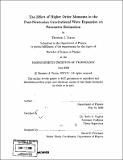| dc.contributor.advisor | Scott A. Hughes. | en_US |
| dc.contributor.author | Torres, Terrence J | en_US |
| dc.contributor.other | Massachusetts Institute of Technology. Dept. of Physics. | en_US |
| dc.date.accessioned | 2009-03-16T19:47:56Z | |
| dc.date.available | 2009-03-16T19:47:56Z | |
| dc.date.copyright | 2008 | en_US |
| dc.date.issued | 2008 | en_US |
| dc.identifier.uri | http://hdl.handle.net/1721.1/44824 | |
| dc.description | Thesis (S.B.)--Massachusetts Institute of Technology, Dept. of Physics, 2008. | en_US |
| dc.description | Includes bibliographical references (p. 51). | en_US |
| dc.description.abstract | The purpose of this thesis is to investigate both the qualitative and quantitative effects of including higher order amplitude terms in the post-Newtonian expansion for gravitational waves on parameter estimation of inspiraling binary systems. First, we review the mechanism behind gravitational wave production and the formalism behind our estimation of parameters given a specific waveform. Then, we use a Monte Carlo simulation of 1000 separate binary systems with random position, and orientation parameters and fixed mass ratios between binary objects to generate gravitational waveforms measurements from a detector model which mimics data received from the proposed LISA mission. After that we numerically estimate how well those parameters are determined. The data presented compares median values of accuracy defined as Aý/ý for parameters ( of luminosity distance, chirp mass, and reduced mass, as well as the major and minor axes of a localization ellipse between waveform models which include only the leading quadrupole harmonic amplitude contribution, and the .5PN amplitude harmonic correction to the quadrupole. Our results show that, for all the Monte Carlo simulations run, there is a substantial global improvement in accuracy of the estimated parameters when higher order .5PN amplitude terms are included in the waveform model. The largest improvement shown comes from the range of masses between 105 and 106 solar masses, which is the ideal reception band for the LISA detector array. This improvement can eventually be applicable to aid in the location of binary sources for confirmation of direct gravitational wave observation. We conclude from these results that it is indeed advantageous to include higher order terms in the post-Newtonian expansion for gravitational wave models in order to obtain more accurate parameter estimates. | en_US |
| dc.description.statementofresponsibility | by Terrence J. Torres. | en_US |
| dc.format.extent | 51 p. | en_US |
| dc.language.iso | eng | en_US |
| dc.publisher | Massachusetts Institute of Technology | en_US |
| dc.rights | M.I.T. theses are protected by
copyright. They may be viewed from this source for any purpose, but
reproduction or distribution in any format is prohibited without written
permission. See provided URL for inquiries about permission. | en_US |
| dc.rights.uri | http://dspace.mit.edu/handle/1721.1/7582 | en_US |
| dc.subject | Physics. | en_US |
| dc.title | The effect of higher order moments in the post-Newtonian gravitational wave expansion on parameter estimation | en_US |
| dc.type | Thesis | en_US |
| dc.description.degree | S.B. | en_US |
| dc.contributor.department | Massachusetts Institute of Technology. Department of Physics | |
| dc.identifier.oclc | 301560667 | en_US |
